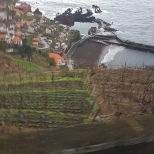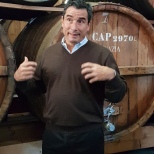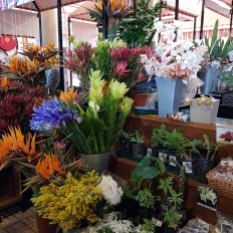

The island of Madeira is a feast for the senses, as are its wines. The rich volcanic soils of this subtropical archipelago, lying closer to the coast of Africa than to the Portuguese capital Lisbon, yield some of the most fascinating and long-lived wines in the world. Generally, oxidised wines that have endured excessive heat are considered to be faulty; however, this is not the case on Madeira. The traditional fortified Madeira wine, once famed throughout the world and even used to toast the United States’ independence from Britain, are deliberately oxidised and exposed to heat to speed the process of madeirisation.
A historical wine
You might wonder how it would enter any winemaker’s head to do this. Well, the story goes back some centuries. Discovered in 1419, Madeira and its archipelago soon became a strategic stopping place for ships to take on food and water, and later wine. The first vines were introduced to the island by prince Henry the Navigator in 1450 in the guise of Malvasia Candida, and Malmsey wine soon became an important export, along with sugar cane, rum and cereals. It was initially a fully fermented table wine, but the practice of fortification was later introduced by the British, similar to Port, to help preserve the wine on long voyages. Wines reached very high temperatures as they were transported in the holds of ships, passing through the tropics several times on their way to India, and sometimes back to Europe, earning them the name Vinho do Roda – round trip wine – in the 18th century. Many believed that the quality and complexity of these wines was improved by this accelerated ageing. This process was then reproduced on Madeira itself by heating wines using estufagem technology – large heated vats. This is still used today, albeit in a somewhat more sophisticated form.
Uniquely diverse
However, it’s not only the madeirisation process that makes the Madeira wines special, and practically indestructible! It’s also the dramatic, mountainous landscape with its laboriously constructed tiny terraces – poios or socalcos – hugging the steep hillsides, where over 2,000 growers farm just 443 hectares of vinis vitifera vines and over 2,200 km of lavadas, or irrigation channels, crisscrossing the island and bringing water from the north to the south. It’s the seven different microclimates on this small island that provide the varied terroir for the permitted varieties, from Malvasia basking in the sun close to sea level to Sercial, known as the dog strangler thanks to its piercing acidity, high up in the wind and clouds. It’s the azure sea surrounding the island, lending the wines their characteristic salinity, and the rich, acidic volcanic soils pumping up their acidity. It’s the bewildering range of styles and categories. Finally, it’s simply their astounding complexity and enduring freshness.
Like other fortified wine, Madeira may currently be out of fashion, but it is certainly worth the attention of any serious wine lover. So, let’s pause for a moment and rewind to the styles of wines on offer.
Styles and categories
Madeira wines may be fortified to 17-22% ABV, but are generally around 19%, and must always be aged for a minimum of three years; then they can be sold with no indication of age or variety. This and the five-year blends are generally the cash cow wines. Then there are blends of 5, 10, 15, 20, 30, 40 or 50 years. They may also be sold as vintage, i.e. stating the year of harvest on the label – Colheita or Frasqueira. Colheitas must spend a minimum of 5 years in cask, while Frasqueira or Garrafeira must spend at least 20 years in cask and the wine must come 100% from that vintage and one variety. They must also be aged using the canteiro process. This is a gentler, slower ageing process, whereby the wines are matured under the rafters in cask for a minimum of two years as opposed to the three months using estufagem technology.
Permitted grape varieties
And now to the grape varieties. The most widely planted and productive variety is Tinta Negra, which is generally used to produce the blended wines. It occupies 239 hectares and is used to produce all styles of Madeira wine from dry to sweet, effectively mimicking the traits of the more noble varieties, depending on where it is planted on the island. Tinta Negra was always considered the poor relative of the other varieties and its name has only been allowed on the labels since 2015!
The variety itself is important with the other cultivars, with the aim being to retain varietal character – although they will lose this after a mere 50 years of ageing! They are used to produce both wines with indication of age and those with indication of year of harvest.

Sercial, vinified to extra dry or dry, boasts lovely freshness, dried fruit, herbal notes, amazing acidity and plenty of salinity. Next down the hillside comes medium dry Verdelho, which is often drunk as an aperitif. Also characterised by fresh acidity, it’s generally more balanced and deeper than Sercial and offers darker dried fruit, salt, vanilla and caramel notes. Boal is perhaps the most quintessential of all Madeira and the style to try if you know nothing about Madeira – it’s long and sweet with plenty of spice, dried fruit and resin, but its acidity means that it still finishes amazingly fresh. Finally, the sweetest of all is Malvasia, or Malmsey, with warming notes of oak, chestnut honey, walnut and Madeira’s distinctive saline acidity. The wines range in colour, depending on variety and age, from pale lemon through pale amber, gold, medium brown, dark brown, and finally brown with hints of green.
There are also tiny amounts of Terrantez, falling somewhere between Verdelho and Boal in style, and the amusingly named Bastardo variety.
Madeira shippers
Nowadays, there are eight companies producing Madeira wine, including one – Madeira Vintners – run only by women.
Visiting Blandy’s traditional lodge and its informative museum and exhibition is easy as it’s right in the centre of Madeira’s orderly capital, Funchal. The Blandy family is one of Madeira’s most significant historical shippers. You should also call into Pereira d’Olivieras, whose tasting room is located in central Funchal, housed in a building dating from 1619, with walls lined with vintage Madeiras labelled with characteristic white stencilling, some of which date back to the 19th century. Luiz Oliviera informs us that at one time they had only bottled wines once they had matured for a hundred years. They have huge stocks of rare old wines, but they will only ever supply a certain number of these, as their policy is to maintain sufficient old wines for the future too.
Henriques & Henriques is located in the former small fishing village of Câmara do Lobos. Charming Humberto Henriques takes us on a comprehensive tour of their facilities, and we learn about one way that Madeira shippers improve their cashflow – by selling barrels that have held Madeira for five years onto Irish whisky makers like Jameson and Bushmills, who then use them to mature their Madeira finish whisky. It also works the other way around, with Madeira being stored in barrels that have previously been used for Cognac, for example, to add complexity. He also explains how they bought 15,000 bourbon barrels from Kentucky, but they were still so heavily charred that they had to invent a makeshift device, using a vacuum cleaner and some brushes, to clean their insides.
Vinhos Barbeito boasts the most recently built winery on the island and its first and only mechanical lagare, which mimics the gentle pressing achieved by treading the grapes by foot. Their wines are pure and precise and there was a queue of people waiting to purchase when we left. Well worth a visit.
Table wine is also produced on the island, often from Verdelho, but an enterprising young lady, Diana Silva is making still wines from the much maligned Tinta Negra variety. Everyone thinks she is crazy and has told her they won’t age well. However, she has pressed ahead and produces a blanc de noir, a rosé and a red, which are all delightfully drinkable and food friendly. She’s also the first producer to bottle wines in magnum.
Madeira is not only about wine
However, the island is not only about wine, there are banana plantations everywhere at low altitude, even on the smallest of terraces, as well as mangos, papayas and sugar cane, the island’s white gold, which may also be turned into rum. The white rum is often used for the local cocktail poncho, which some say was used by 16th century Portuguese navigators to prevent scurvy – lemons were preserved in a mixture of rum and sugar cane to be consumed on long voyages. Nowadays, it’s a concoction of white rum, fresh orange and lemon juice, sugar and honey. It’s also said to be a cure for sore throats and colds.
Thanks to the island’s year-round mild weather and stunning scenery that changes dramatically from one part of the island to the next, wine production has now been overtaken by tourism, unfortunately putting land prices out of the reach of many growers but enabling us to enjoy this island paradise.
Funchal makes a lovely base; you can visit the colourful Mercado dos Lavradores, stroll around the picturesque town and along the street of painted doors, or take the cable car up to the botanical gardens. Cristiano Ronaldo was born here, so football fans can even take in the museum founded in his honour.
The entire island offers superb views across steep hills, lush valleys and windswept coastal cliffs. Make sure you don’t miss the Piscinas Naturais in Porto Moniz, a series of rock pools jutting into the ocean where you can swim in sea water, and the Fajã dos Padres, a natural wonderland at the bottom of a steep cliff boasting a restaurant and accommodation, accessible only by cable car. You can even hike along the levadas up in the hills and enjoy the breath-taking landscape while remembering the hard work the original settlers put in to make this inhospitable island of steep hills and forests habitable and to be able to cultivate the vines to produce the amazing Madeira wine we can still enjoy today.
This article was first published in Hungarian in the October edition of Vince magazine.


























































































































